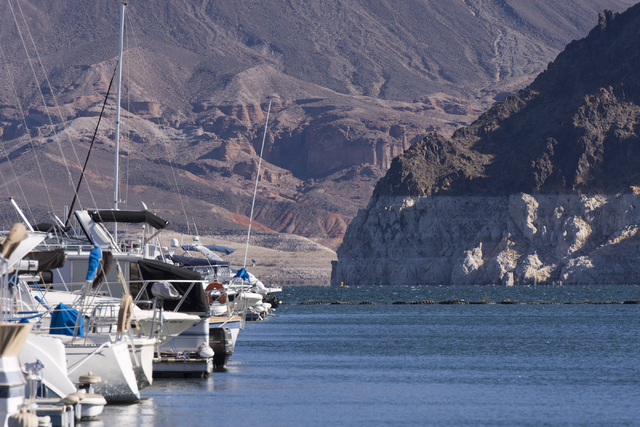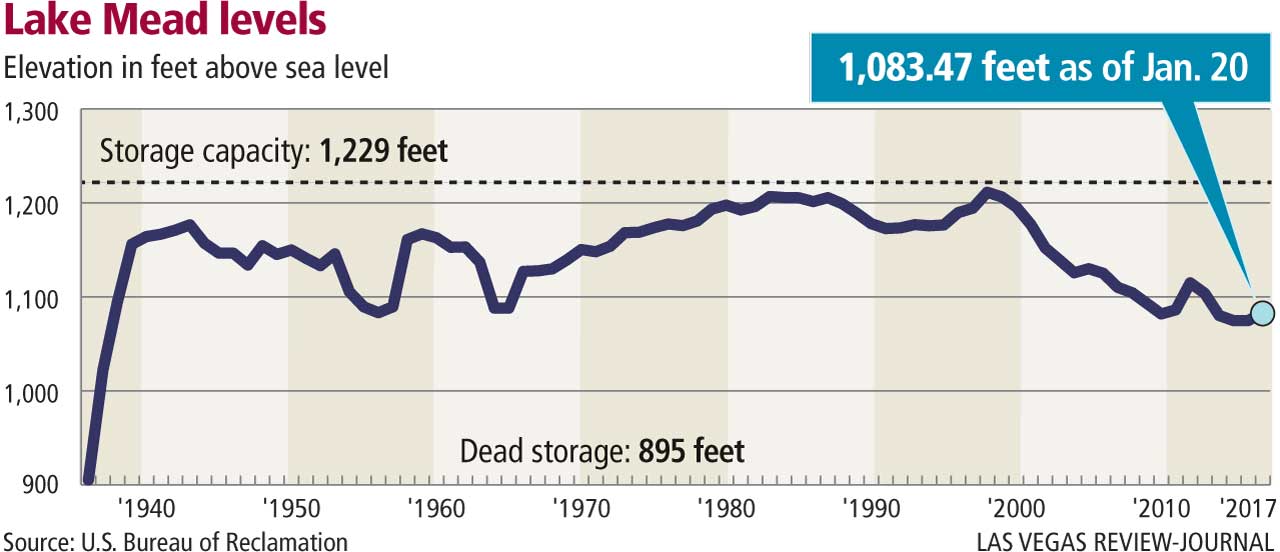Early snowpack indicates ‘coin flip’ for Lake Mead shortage declaration in 2018


Snow is piling up in the Rockies and Sierra Nevada, but this year’s first official water forecast for the Colorado River still predicts Lake Mead will shrink enough to trigger a federal shortage declaration in 2018.
Federal forecasters expect the lake’s surface to drop by about 9 feet by the end of 2017, which would put it inches below the all-important shortage line of 1,075 feet above sea level. That would force Nevada and Arizona to cut their use of Colorado River water under rules adopted a decade ago.
“We remain at more or less a coin flip” for a shortage declaration in 2018, said Greg Walch, general counsel for the Southern Nevada Water Authority, in a report to the agency’s board on Thursday.
But such early season forecasts don’t always hold water, and Walch said he is “cautiously optimistic” that recent winter storms in the Rocky Mountains could mark the start of a wet year on the Colorado.
“What’s bad for air travel seems to be good for snowpack in the Rockies,” he said. 
SIERRA SNOW COULD HAVE IMPACT
The picture is much rosier — and whiter — in California’s drought-ravaged Sierra Nevada range, where snow accumulations are well above average for this time of year. The southern end of the range especially has received almost double its normal amount of snow so far.
While that precipitation doesn’t directly benefit Lake Mead or Southern Nevada, it could help reduce California’s need for Colorado River water by refilling reservoirs within the Golden State.
“Certainly the potential is there for the draw on the river from California to be reduced,” Walch said.
The surface of Lake Mead has dropped almost 130 feet since the current drought affecting the Colorado River drainage basin began in 2000.
In the event of a first-ever federal shortage declaration, Nevada would have to reduce its river use by 4 percent while Arizona would take an 11 percent cut.
The Las Vegas Valley draws 90 percent of its water supply from the Colorado by way of Lake Mead, but authority officials said the community has already conserved more than enough to easily absorb a shortage.
The river forecast comes as negotiations continue on a pair of agreements that could help slow Lake Mead’s decline.
Nevada, California and Arizona are closing in on a drought contingency plan, under which the states would voluntarily reduce their use of Colorado River water to prop up the reservoir. Arizona and Nevada would bear the brunt of the cuts early on, but California would also accept reductions to its share of the river for the first time under the deal.
NEGOTIATIONS WITH MEXICO
At the same time, water officials in the U.S. and Mexico are in talks to extend and expand a treaty that governs how the Colorado is managed across the international boundary.
The new agreement, known as Minute 32X, lets Mexico continue storing some of its annual river allotment in Lake Mead and allows U.S. water agencies to invest in water-saving projects south of the border for a share of the water that is saved. It also spells out Mexico’s share of any shortages that might be declared on the river.
Minute 32X builds on an existing treaty amendment set to expire at the end of the year.
Southern Nevada Water Authority General Manager John Entsminger said he and his fellow negotiators pushed to finalize both agreements before the change in presidential administrations to avoid any delay or disruption in the talks. That didn’t happen, but outgoing Interior Secretary Sally Jewell on Wednesday issued an order directing the department and its bureaus to see the two initiatives through to completion after she is gone.
Entsminger said he’s optimistic that the deals will get done sometime this year.
Contact Henry Brean at hbrean@reviewjournal.com or 702-383-0350. Follow @RefriedBrean on Twitter.












